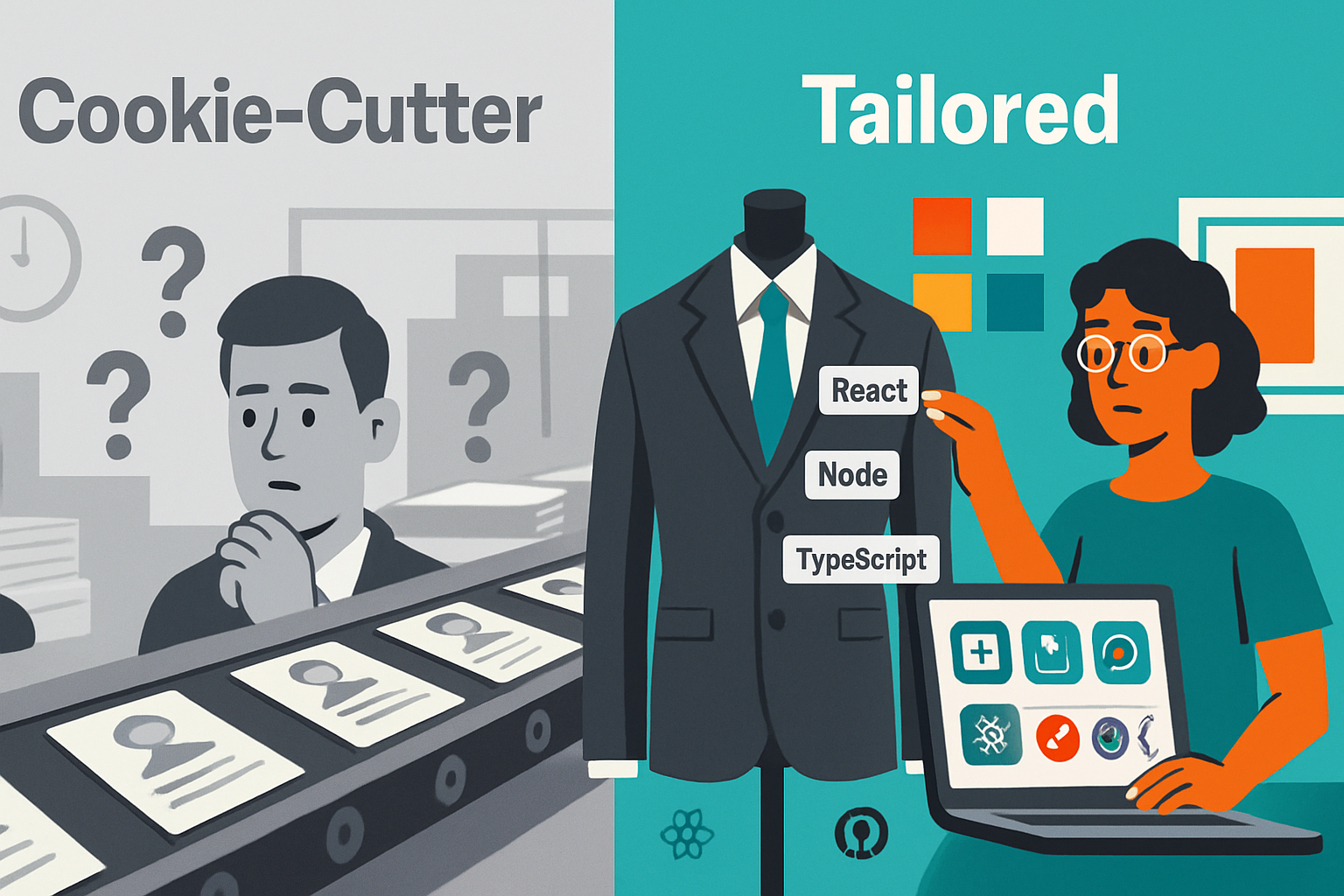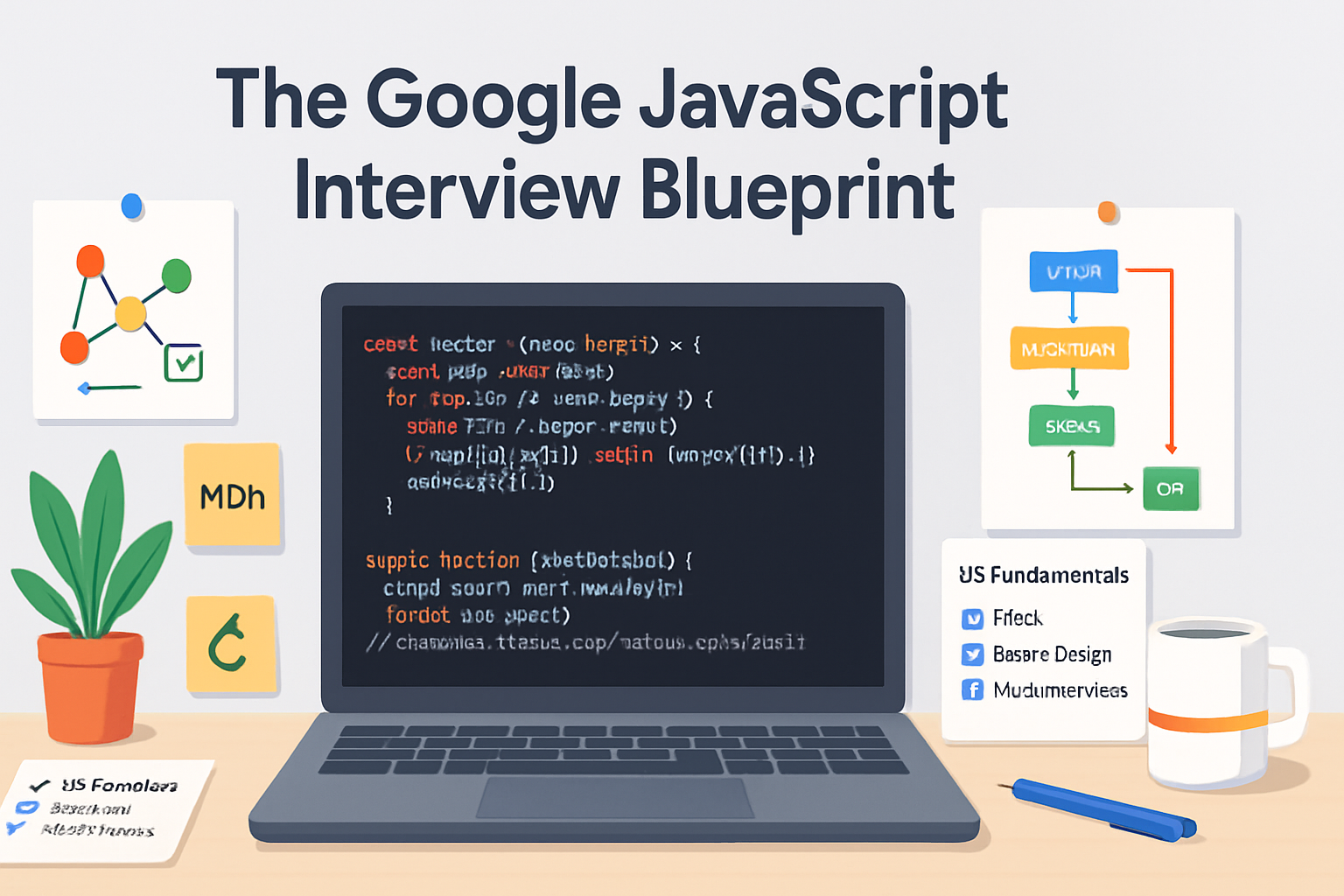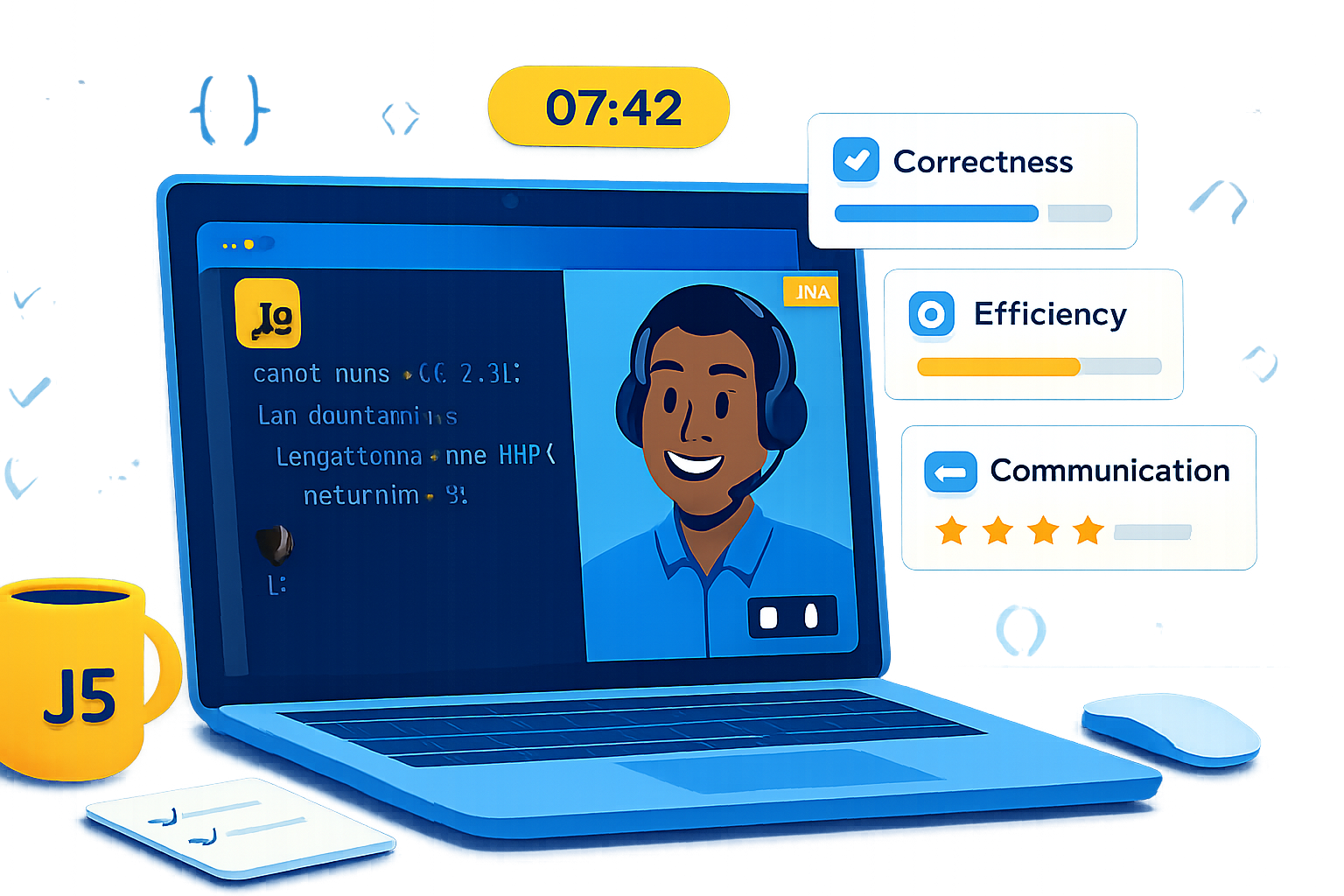· career · 7 min read
The 'One Size Fits All' Approach: Why It Fails in JavaScript Interviews
Generic interview tactics rarely win JavaScript roles. Learn why cookie-cutter answers fail, how to research roles and companies, and step-by-step ways to tailor your technical and behavioral preparation for frontend, backend, and full‑stack JavaScript positions.

Get the right job - not the generic one
By the end of this post you’ll have a repeatable approach to tailor your JavaScript interview prep so it matches the role, the tech, and the team. That means fewer wasted hours studying irrelevant topics, more confident answers in interviews, and a much higher chance of getting the offer.
Interviews are not tests of how much you can memorize. They’re signals: can you solve the problems this team actually has? A cookie-cutter strategy hides your judgment. Tailoring reveals it.
Why “one size fits all” fails for JavaScript roles
Short answer: different roles ask for different skills. Long answer: the differences accumulate into a huge mismatch.
- Role-specific skills vary wildly. A React UI engineer is judged on accessibility, rendering performance, component design and browser quirks. A Node.js backend engineer is judged on concurrency, streams, observability and deployment. Treating these as the same wastes time.
- Company expectations and constraints differ. Startups may prioritize velocity and shipping features. Enterprises might prioritize reliability, testing, and backward compatibility. Your examples should reflect that.
- Interview formats vary. Some companies prefer take-home projects. Others prefer pair-programming. You must rehearse the right format.
- Behavioral signals matter. Teams hire for culture fit and collaboration style. Generic, textbook answers sound rehearsed. Tailored answers show judgment and context-awareness.
A single canned answer can’t signal the right mix of technical depth, system thinking, and product judgment. Your preparation must.
Where to focus - interview types and the skills they probe
Match your prep to the interview format you’ll face:
- Whiteboard / live coding: algorithmic clarity, problem decomposition, and communication. Useful for platform, infrastructure, and algorithm-heavy roles.
- Pair-programming / take-home: real-world code structure, readability, testing, and trade-offs. This mirrors day-to-day engineering.
- System/Architecture design: high-level trade-offs, scalability, fault tolerance, API design, and operational concerns.
- Frontend deep-dives: rendering lifecycle, accessibility (a11y), bundle size, hydration, CSS strategies, browser APIs, performance profiling.
- Backend deep-dives: concurrency model, data modeling, API design, security, caching, observability, deployment.
- Behavioral/Product interviews: impact, trade-offs, cross-team communication, and user empathy.
Knowing which of these you’ll face changes what you practice.
How to research the role and company effectively
Preparation starts with reconnaissance.
- Decipher the job description. Extract explicit stack items (React, TypeScript, Node, GraphQL) and implicit signals (“scale”, “low-latency”, “consumer-facing”). If the description mentions “scale”, expect system-design questions. If it mentions “polish” or “a11y”, focus frontend UX.
- Inspect the company’s tech presence. Check their GitHub, tech blogs, engineering posts, and job postings for recurring libraries or patterns. Open-source repos often show the stack and coding style.
- Talk to insiders. If possible, reach out to current or former employees on LinkedIn or Twitter and ask what the interview focuses on.
- Read the interview guide or candidate FAQ if provided. Many companies publish guidance (and hints) about formats and expectations.
References you can use:
- MDN’s JavaScript guides and event loop explanation: https://developer.mozilla.org/en-US/docs/Web/JavaScript/Guide and https://developer.mozilla.org/en-US/docs/Web/JavaScript/EventLoop
- Node.js guide on event loop & concurrency: https://nodejs.org/en/docs/guides/event-loop-timers-and-nexttick/
- Google Web Fundamentals on performance: https://developers.google.com/web/fundamentals/performance
- The System Design Primer (for architecture prep): https://github.com/donnemartin/system-design-primer
How to tailor your technical preparation (role-by-role)
Below are playbooks for common JavaScript roles. Use them as templates and adapt to the company signals you discovered.
Frontend (React / framework-focused)
- Master rendering lifecycle, reconciliation, and state management patterns. Know when to memoize and why.
- Focus on performance: code-splitting, lazy-loading, critical rendering path, and bundle analysis tools.
- Accessibility and semantics: know ARIA, keyboard interactions, and screen reader basics.
- Browser APIs and CSS: understand layout, repaint/reflow, and how to debug paint issues.
- UI testing and E2E: testing-library, Cypress, Jest snapshots.
- Prepare a UI-focused take-home demo or a small portfolio that highlights component design, tests, and performance metrics.
Backend (Node.js / services)
- Concurrency and the event loop: know non-blocking patterns, streams, and worker threads.
- API design, data modeling, transactional integrity, and caching strategies.
- Observability: structured logs, metrics, tracing (OpenTelemetry), and error handling.
- Security: input validation, XSS/CSRF basics for HTTP services, and OWASP concerns.
- DevOps: deployment patterns, Docker, CI/CD pipelines.
- Practice debugging production-like issues and building minimal, well-tested services with clear error boundaries.
Full‑stack
- Combine the above but prioritize interfaces and contracts between client and server (GraphQL/REST, error handling, optimistic updates).
- Practice building and deploying a small feature end-to-end: UI, API, DB, and tests.
- Be able to explain trade-offs about where logic lives (client vs server) and how to test integration points.
Framework / Library Specialist
- Expect deep questions about internals, performance characteristics, and upgrade/migration strategies.
- Read the codebase or RFCs (if open-source) and be ready to suggest incremental improvements.
Platform / Infra (JavaScript runtimes, build tools)
- Focus on build tooling, bundlers, caching strategies, and runtime constraints.
- Expect to discuss scaling, multi-tenant considerations, and authoring reproducible builds.
Tailoring behavioral answers - more than STAR
The STAR method (Situation, Task, Action, Result) is useful. But tailor it:
- Contextualize to the role. If interviewing for frontend, emphasize user impact, accessibility outcomes, and UX testing. For backend, emphasize reliability, latency improvements, and system metrics.
- Quantify outcomes. Replace vague claims like “improved performance” with measurable results: “reduced TTFB from 400ms to 120ms for 90th percentile”.
- Convey constraints and trade-offs. Interviewers want to hear why you chose one path and what you sacrificed.
Example (frontend-tailored):
- Situation: “Our checkout had a 30% abandonment rate on slow networks.”
- Task: “Reduce load time and simplify critical path for checkout.”
- Action: “Introduced code-splitting, deferred non-critical fonts, and switched to adaptive image formats; added Lighthouse budgets and CI checks.”
- Result: “Checkout LCP improved from 4.5s to 1.8s on 3G emulated networks and conversion improved by 12%.”
This reads differently to a frontend team than a generic “we improved performance” story.
Tailoring take-home projects and portfolio
A take-home assignment is your resume in code form. Treat it like a production deliverable.
- Align the problem to the company’s needs. If they care about scale, show how your solution handles increased load or how it degrades gracefully.
- Ship a small README that explains your decisions, trade-offs, and how you validated them (benchmarks, screenshots, accessibility audit reports).
- Include tests and explain your CI setup. A quick deploy (Netlify, Vercel, or Heroku) makes it easy for interviewers to run your demo.
- Show observability: a basic metrics dashboard or logs are extra credit.
Practical prep routine - make it tactical
Here’s a two-week focused plan for an upcoming interview. Adjust length based on how much time you have.
Days 1–2: Recon
- Read the JD, company blog, and GitHub. Make a role tech-stack map.
Days 3–6: Core skills
- Frontend: one polished component + performance audit.
- Backend: small service with metrics and tests.
- Algorithms: 3–5 representative problems relevant to the role (not 100 random problems).
Days 7–9: Mock interviews
- Do 2–3 mocks that match the company format. Record and review.
Days 10–12: Polish take-home / portfolio
- Deploy, write README explaining trade-offs, and add tests.
Days 13–14: Behavioral and Q&A prep
- Prepare 6 tailored stories for common behavioral threads. Prepare 8 intelligent questions to ask the interviewer (team structure, release cadence, performance goals).
A tangible checklist before the interview
- I can explain why my sample projects reflect the company’s priorities.
- I can identify 3 specific technical challenges this team likely faces.
- I have 4–6 role-specific stories (impact + metrics).
- I practiced at least one mock in the company’s expected format.
- My code demos have README + tests + deployed demo (if feasible).
- I know what skin in the game I have: what I will prioritize in my first 90 days.
Sample tailored answers (short)
Frontend question: “How would you improve perceived performance for a dashboard app?”
- Short tailored answer: “I’d measure current metrics (LCP, FID), then prioritize reducing main-thread work with web workers for heavy computations and use skeleton UIs for perceived speed. If the dashboard is data-heavy, add streaming or pagination and prefetch critical datasets. I’d add Lighthouse budgets to CI to avoid regressions.”
Backend question: “How do you handle spikes in traffic?”
- Short tailored answer: “Implement autoscaling with rate-limiting at the edge, cache hot reads (consider Redis with TTL), and use backpressure on workers; instrument end-to-end tracing so we can identify hot paths during spikes. If stateful, evaluate sticky sessions or move to a stateless token pattern.”
These answers are succinct and show role-aware trade-offs.
Common pitfalls when tailoring (and how to avoid them)
- Overfitting: Don’t build a bespoke solution for a hypothetical company detail you guessed. Base tailoring on signals (JD, blog posts, repos, conversations).
- Being too shallow: Tailoring doesn’t mean surface-level buzzwords. Back up each claim with a quick explanation or metric.
- Forgetting fundamentals: Even if you’re targeting a frontend role, expect basic data-structure and algorithm reasoning in many companies. Cover the essentials.
Final thought - tailoring is judgment made visible
Generic preparation hides your decision-making. Tailored preparation reveals it. It shows you read the role, understood the team, and can ship work that fits constraints. That is what interviewers hire for: not just a coder, but a matchmaker between problem and solution.
Start small. Pick one interview, map the top three signals from the job post and the company, and adjust your study plan accordingly. The effort is modest. The payoff is disproportionate.



